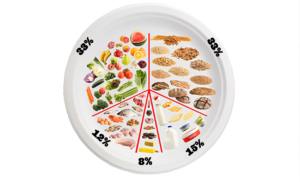Eat well plate

The Government’s Eat Well plate perfectly illustrates how our diets should be portioned
This ensures the perfect balance for maximum health. It’s useful to try and get this balance every day from each food group, but if it’s not possible try and look at the diet of you or your family over a week so you can tweak where you need to add in things that may have been lacking for a couple of days.
Below is an overview of the Eatwell plate and the sort of foods that fall within each category.
Fruit & Vegetables
Needed to: Provide fibre and essential vitamins
Percentage of daily intake: 33%
Try: for five portions a day. Start the day by adding some blueberries to your porridge, an apple in a lunchbox, crunch carrot sticks for lunch, and a side of veg with your dinner and you’re almost there!
Starchy Carbohydrates
Needed to: give us a good source of energy
Percentage of daily intake: 33%
Try: bread, potatoes, rice and pasta, which are all starchy carbohydrates. Containing fewer than half the calories of fat (gram for gram) just be aware what you serve them with to keep them a healthy option!
Milk & Dairy Foods
Needed for: calcium helps to keep our bones and teeth strong, and is essential for growing children
Percentage of daily intake: 15%
Try: cheese and yogurt are excellent sources of calcium
Meat, fish, eggs and beans
Needed to: provide the building blocks for bones, muscles, skin and blood.
Percentage of daily intake: 12%
Try: grilled or baked cod, chicken or lean red meat. Pulses like lentils, chickpeas and beans are excellent sources of protein, as is tofu and quinoa. Oily fish like tuna, mackerel or salmon are also great sources of Omega 3.
Food & drinks high in fat and/or sugar
Needed to: enjoy as a treat, and look for healthier options where possible
Percentage of daily intake: 8%
Try: to eat good fats such as monounsaturated and polyunsaturated fats found in olives, unsalted nuts, seeds and tuna, salmon and sardines. Avoid foods that are high in saturated fats like biscuits, cakes and pastries and replace them with unsalted nuts, olive oil and avocados




